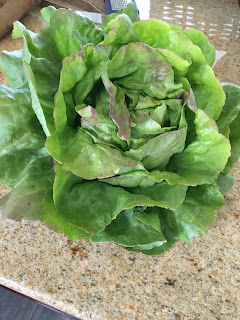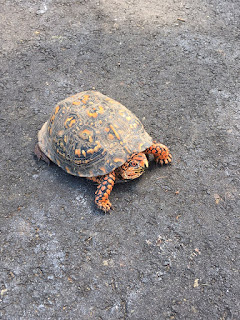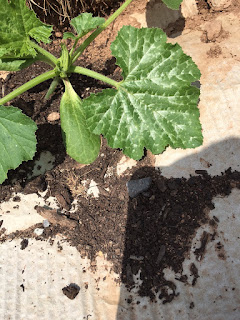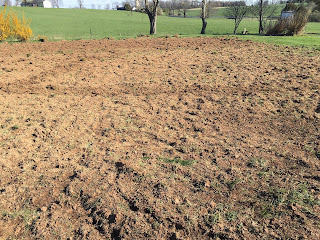It was mid summer of 2016. My beautiful summer squash was growing in excess of what I can consume on a daily basis. I cooked some and froze some more. It was still a lot. One fine afternoon, I walked down to my neighbor's house and knocked the door. I smiled, introduced myself and told her about my vegetable garden. The neighbor was a little surprised seeing someone on a weekday at 12:00 pm on doorstep handing summer squash. As I chatted, she mentioned how she and her husband wanted to have a vegetable garden but couldn't do it anytime. The reason was the thought of too much work watering, weeding, looking after for the garden, kids, job etc. I wanted to argue against the idea but thought would be bit too much for a first meeting. So, I just nodded. The neighbor accepted my squash and told me that she loves to cook vegetables for dinner.
Many years back, I used to visit a flower garden . It belonged to one my grandparents' neighbors. On my occasional visits to the garden during summer vacations, I, along with my grandfather, would stroll the beautiful flower garden for a good long hour. My grandfather would chat with the owner, who was a tailor by profession. Rows of fragrant flowers made the garden a tropical paradise. The owner had built a wall along the perimeter of his garden to keep unwanted visitors and mischievous kids at bay. The garden was actually a hidden treasure. This was in the 1990s in a town in central India. Shops and residences were all that neighborhood had. My trips to the garden were always with my grandfather. The owner never allowed unaccompanied kids :) Many years later I learnt that the entire neighborhood was vacated to free space for a commercial center.
Below, I have outlined reasons why people do not prefer to grow food in their backyard. I won't call these reasons myths. The purpose of outlining these reasons in details is to help alter the mindset that self-imposes these restrictions.
Many years back, I used to visit a flower garden . It belonged to one my grandparents' neighbors. On my occasional visits to the garden during summer vacations, I, along with my grandfather, would stroll the beautiful flower garden for a good long hour. My grandfather would chat with the owner, who was a tailor by profession. Rows of fragrant flowers made the garden a tropical paradise. The owner had built a wall along the perimeter of his garden to keep unwanted visitors and mischievous kids at bay. The garden was actually a hidden treasure. This was in the 1990s in a town in central India. Shops and residences were all that neighborhood had. My trips to the garden were always with my grandfather. The owner never allowed unaccompanied kids :) Many years later I learnt that the entire neighborhood was vacated to free space for a commercial center.
Below, I have outlined reasons why people do not prefer to grow food in their backyard. I won't call these reasons myths. The purpose of outlining these reasons in details is to help alter the mindset that self-imposes these restrictions.
- Gardening is too much work: You sow seeds, half of them fail to germinate, some may be eaten by critters and some may succumb to harsh weather. Isn't it easier to just walk down superstore and get our grocery ? The convenience of superstore is good for purchasing a product you cannot make at home. Food items are one of them too. Not all the food products that we consume daily can be grown in one's backyard. Not everyone has a backyard. Unlike in United States, where quality control of food items is practiced and enforced on farmers and stores alike, it is not so in other countries. Citizens are depended upon whatever produce farmer's markets sell. Ideally, the food at the farmer's markets on open streets should be of top quality and fresh. However, it is not. Those who do not wish to avoid farmer's markets run to the stores. Much of the food in stores comes either from the same farmers or has traveled thousands of miles to reach stores. There is no way to know what practices farmers have used to grow food. The first and the most important benefit of growing food in your garden is the quality control and visibility of the produce from start till the end. You know the seed you are buying, the soil you are using and the harvest you are getting. You know you are not spraying chemicals on leaves or fruit. You know your tomato is not ripened in artificial mediums. For the health benefits that such a quality produce gives, I would say the cost is worth the effort.
- Food is all the same: It isn't. Two tomatoes grown in different soils and with different agricultural practices are not the same. Just because it looks nice and red without blemishes does not mean it was grown with sound and safe practices. If you cannot avoid buying the produce, which I know in many parts of the world, consumers have to buy what the market sells, at least buy with awareness. As the saying goes ' All that glitters isn't gold'.
- All my plants fail and die: There are lots of plants and herbs that are easy to grow in your local climate and in less than ideal soils. If we only once do the effort of finding out about them, gardening would be doable. Some cities have agriculture agents and extensions for help. It is a matter of picking up your phone and reaching out to them. Where there isn't much help and information available on gardening topics, go experiment. Buy some seeds, throw in some compost and see if it grows. If it doesn't grow, find out about what grows best in your local geography. Knowing the right conditions in which a plant thrives and providing the it those conditions and nutrients is the key to successful growing. I would like to add here that creating right conditions in poor soils can be a bit of a challenge but totally doable. It takes time though. Grow plants that thrive well and are easy to grow than growing something which you fail at. Once you get better at understanding your soil, weather and plant needs, you can grow the difficult ones. I would like to mention here that plant that take a long time to harvest (more than 4 weeks or so) are prone to pests if left by themselves without proper care. That being said, many of those plants, can have a good yield if maintained well.
- Too long and too little harvest: A common statement that one very often hears is "I planted some seeds and got a handful of harvest which was consumed in a day. So much work and it was over in a day". It happens. However, even with that little harvest, you learnt what grows well. Plant more of the same next time. Plant seeds in succession. Succession planting vegetables that you love to eat is a way to ensure that you get a continuous harvest over the growing season. Additionally, you can plant quick growing annuals instead of vegetables that take a long time to harvest. Cilantro, basil, dill, rosemary and mint are some of the many quick growing herbs that survive summer and fall weather here. Many microgreens and leafy salad greens consume very less space and can be harvested in less than 4 weeks.
- Ain't no time here: The worst of all the excuses is the excuse of being short on time. We all got the same 24 hours. And yes, after work, home, kids and numerous other tasks, there is little time left to do strenuous activity. We should remember that if we have less than ideal growing conditions for plants, we have to give some time to fix it. We either hurry up or give up. When playing with nature, understanding it is better than resisting or fighting to make things work. A little reading and a little experiment is all that is needed to make it work. Connecting is nature in big and small ways is always very therapeutic. For anyone who has harvested produce from their backyard for the very first time, knows the feeling of joy that comes from it. No looking back thereafter. That said, a commitment to grow some food is not possible for every household at all times. For those that have travelling professions, or are taking care of an elderly parent or sick child, catering to a garden can be an additional workload.
- The weather killed it: We all know that one day of heavy rain, winds or icy sleet can ruin all the effort in a day. Gladly, on a small garden, unlike a large farm, you can control things to some extent. Row covers of many kinds of available that when laid on plants or seed bed, offer some degree of protection from harsh elements. Growing in pots or hoophouses offers additional protection and flexibility of moving around. I have written a post on how I built my first hoop house. It is a bit more effort and additional expense but if a little effort and expense (within budget) protects something you love, it's totally worth it. Rest assured, it is less expensive than a Kate Spade handbag ☺.
For me, growing food is a creative endeavor. Any creative endeavor when done with intent is immensely satisfying. Besides, food has connected people from centuries. Traditions and cultures have evolved around food. Growing food should not be seen as rural profession practiced by a handful farmers who are in it. Gardening, should be done with an intent to eat healthy, nourishing food while learning a skill that teaches us to be humble and respectful of mother nature. I understand that the non-availability of gardening tools and supplies can be a limiting factor in many towns and cities. Not all supplies are available in nearby shops, not all shops are a Walmart or Home Depot. Online presence and availability of garden stores isn't easy in some countries. Let's then change it. The more we start a trend which is good for our community, the more we encourage others to adopt it.



































